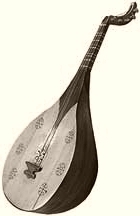بربط
البربط[1][2] (بالفارسية: بربت) هو هو عود ذو أصل فارسي كبير منتشر في جميع أنحاء آسيا الوسطى وخاصة منذ الإمبراطورية الساسانية.[3] ويتميز البربط بأنه منحوت من قطعة واحدة من الخشب، بما في ذلك الرقبة ولوحة الصوت الخشبية. [3] من المحتمل أنها كانت آلة ذات سطح جلدي لمدة من الزمن، وهي تعود إلى العود ذات السطح الخشبي والقنبوص اليمني ذو السطح الجلدي.[3][4][5][6]
اخترع صانعو الآلات الموسيقية الإيرانيين المعاصرين أداة جديدة مستوحاة من البربط مع اختفاء البربط الأصيل.[7] الآلة الحديثة المعاد صنعها تشبه العود، مع وجود اختلافات منها صغر البدن، وطول العنق، ولوحة أصابع مرتفعة قليلاً، وصوتٍ مختلفٍ عن صوت العود. [7]
التأثيل
عدلالبربط أصله فارسي من بر أي صدر وكلمة بط العربية فيعني صدر البطة.[2]
انظر أيضا
عدلالمراجع
عدل- ^ مجدي وهبة؛ كامل المهندس (1984)، معجم المصطلحات العربية في اللغة والأدب (ط. 2)، بيروت: مكتبة لبنان ناشرون، ص. 77، OCLC:14998502، QID:Q114811596
- ^ ا ب Tobia Al-Anisi, the Lebanese Halabi، تفسير الألفاظ الدخيلة في العربية مع ذكر أصلها بحروفة، ص. 7، QID:Q117357294
- ^ ا ب ج During، Jean (15 ديسمبر 1988). "Encyclopaedia Iranica - Barbat". Iranicaonline.org. مؤرشف من الأصل في 2023-10-05. اطلع عليه بتاريخ 2012-02-04.
- ^ Lawergren، Bo؛ Farhat، Hormoz؛ Blum، Stephen (20 يناير 2001). "Iran". Grove Music Online. ج. 1. DOI:10.1093/gmo/9781561592630.article.13895.
The 'ūd (lute) is believed to be a later development of a pre-Islamic Persian instrument called barbat.
- ^ Blum، Stephen (20 يناير 2001). "Central Asia". Oxford Music Online. Oxford Music Online, Grove Music Online. DOI:10.1093/gmo/9781561592630.article.05284.
The 'ūd (lute) is believed to be a later development of a pre-Islamic Persian instrument called barbat...[was part of] eastwards diffusion of Middle Eastern and Central Asian chordophones... the pipa, likewise derived from the barbat or from its prototype
- ^ Hilarian, Larry Francis (2003). "Documentación y rastreo histórico del laúd malayo (gambus)" [Documentation and historical tracking of the Malay lute (gambus)]. Desacatos (بالإسبانية) (12): 78–92. Archived from the original on 2022-12-25.
El gambus melayu que ahí llegó podría ser, o bien un descendiente directo del barbat persa, o del qanbus yemenita, que a su vez evolucionó del barbat.[translation: The melayu gambus that arrived there could be either a direct descendant of the Persian barbat, or the Yemenite qanbus, which in turn evolved from the barbat.]
- ^ ا ب Goldrick، Navid (16 أغسطس 2013). "Persian Oud – Barbat". majnunn music and dance. مؤرشف من الأصل في 2019-12-04. اطلع عليه بتاريخ 2018-03-31.
In the last 40 years...luthiers in Iran have been conducting research on old paintings... to best reproduce the Barbat of old.
